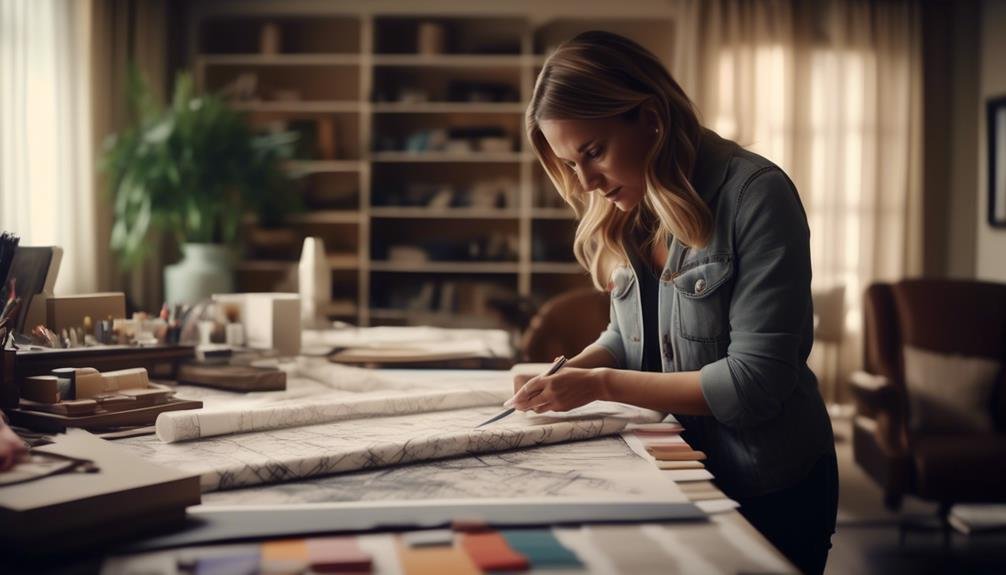Certified Interior Designer
If you have a passion for design and a keen eye for detail, becoming a certified interior designer could be the perfect career path for you.
But what exactly does it take to achieve this prestigious designation and what opportunities await once you've earned it?
Let's uncover the essential steps and requirements for becoming a certified interior designer, as well as the exciting possibilities that come with this title.
Key Takeaways
- Certified interior designers have met educational and experience requirements and have passed a rigorous exam to demonstrate their knowledge and skills.
- Certification ensures that interior designers adhere to industry standards, creating safe, functional, and aesthetically pleasing spaces that comply with building codes and regulations.
- The educational requirements for certification include obtaining a degree in Interior Design from an accredited institution, which provides knowledge in design theory, space planning, color theory, and practical elements like architectural drafting and computer-aided design.
- Gaining practical experience through internships, apprenticeships, and real-world projects is essential for interior designers to apply their theoretical knowledge, learn from professionals, network with industry experts, and enhance their portfolio.
Understanding the Role of a Certified Interior Designer
If you've ever wondered what sets a certified interior designer apart from other interior designers, you're about to gain a clear understanding of their unique role in the design industry. Understanding certification is crucial.
Certified interior designers have met specific educational and experience requirements and have passed a rigorous exam to demonstrate their knowledge and skills. This certification ensures that they adhere to industry standards and possess the expertise necessary to create safe, functional, and aesthetically pleasing spaces.
The role of interior designers extends far beyond just choosing colors and furniture. Certified interior designers are trained to consider aspects of design that impact the health, safety, and welfare of the public. They're adept at creating spaces that aren't only beautiful but also comply with building codes and regulations.
Additionally, their expertise in client communication allows them to understand and interpret their clients' needs, translating them into innovative and practical design solutions. This level of professionalism and attention to detail sets certified interior designers apart in the design industry, ensuring that their work meets the highest standards while prioritizing the client's vision and satisfaction.
Educational Requirements for Certification
To become a certified interior designer, you'll need to have a degree in Interior Design from an accredited institution. Additionally, most certification programs require a certain amount of professional experience in the field, usually ranging from one to three years.
These educational requirements ensure that certified interior designers have the necessary knowledge and practical skills to excel in their profession.
Degree in Interior Design
Getting a degree in interior design is an essential step towards meeting the educational requirements for certification as an interior designer. Pursuing a degree in interior design is the gateway to a rewarding interior design career.
The interior design curriculum typically encompasses a diverse range of subjects, including design theory, space planning, color theory, architectural drafting, and computer-aided design (CAD). Additionally, coursework often delves into materials and finishes, lighting design, building codes, and sustainability. The program may also incorporate practical elements such as internships or hands-on projects to provide real-world experience.
Professional Experience Requirement
Upon completing your degree in interior design, you'll need to fulfill a professional experience requirement as part of the educational qualifications for certification as an interior designer. This requirement is essential for gaining practical skills and industry knowledge. Here's what you can expect:
- Internship opportunities: Seek out internships to gain real-world application of your theoretical knowledge.
- Mentorship programs: Engage in mentorship programs to connect with experienced professionals who can provide guidance and industry insights.
- Industry connections: Network within the industry to build valuable connections and learn from established professionals.
- Hands-on projects: Look for opportunities to work on hands-on projects to apply your skills in real-world scenarios.
- Client interactions: Gain experience in interacting with clients to understand their needs and preferences, an essential skill for a successful interior designer.
This practical experience will complement your academic learning and prepare you for a successful career in interior design.
Gaining Practical Experience
Embarking on an apprenticeship or internship with an established interior designer can provide invaluable practical experience crucial to your certification journey. These opportunities offer hands-on learning experiences and the chance to network with industry professionals while working on real-world projects. Here's a closer look at what you can expect from such an experience:
| Practical Experience | Benefits | Importance |
|---|---|---|
| Internship Opportunities | Gain firsthand experience in the field, learn from seasoned professionals, and apply theoretical knowledge to practical situations. | Essential for honing your skills and gaining a deeper understanding of the industry. |
| Hands-On Learning | Engage in designing spaces, selecting materials, and collaborating with clients, fostering a comprehensive understanding of the design process. | It allows you to put your knowledge into action and develop problem-solving skills. |
| Networking with Industry Professionals | Build connections with established designers and potential employers, opening doors to future career opportunities. | Establishing a professional network is vital for career growth and staying updated on industry trends. |
| Real-World Projects | Work on actual design projects, from conception to completion, and learn to navigate challenges that arise during the process. | It prepares you to handle the complexities of real client projects and enhances your portfolio. |
Embarking on an apprenticeship or internship with an established interior designer is an enriching way to gain practical experience and accelerate your journey towards becoming a certified interior designer.
Developing Essential Design Skills
To become a well-rounded interior designer, you need to master essential design skills that encompass color theory basics, space planning techniques, and material selection tips.
By understanding the psychology of color and its impact on a space, you can create harmonious and visually appealing designs.
Effective space planning techniques will allow you to optimize the functionality and flow of a room.
Mastering material selection will ensure that your designs aren't only aesthetically pleasing but also durable and practical.
Color Theory Basics
Understanding the principles of color theory is essential for interior designers to create harmonious and impactful designs that resonate with their clients' vision and preferences. When it comes to color theory basics, here are some essential points to consider:
- Color Psychology: Explore how different colors can evoke specific emotions and moods, and how to use this knowledge to create the desired atmosphere within a space.
- Design Trends: Stay updated on current color trends in interior design to ensure that your designs feel fresh and modern.
- Color Wheel: Familiarize yourself with the color wheel and how different color combinations can create various effects within a space.
- Color Harmony: Learn about complementary, analogous, and monochromatic color schemes to achieve balance and visual interest in your designs.
- Application: Understand how to apply color theory to different elements of interior design, such as walls, furniture, and accessories, to create cohesive and visually appealing spaces.
Space Planning Techniques
As you dive into mastering space planning techniques, you'll harness the principles of color theory to create seamlessly integrated and functional designs that optimize the use of every square foot. Space utilization and floor plan optimization are crucial aspects of interior design, and by understanding these principles, you can create spaces that are both aesthetically pleasing and practical. To achieve this, consider the flow of movement within a space, the placement of furniture, and the utilization of natural light. Additionally, incorporating multifunctional furniture and clever storage solutions can further maximize the use of space. Here's a quick reference guide to some essential space planning techniques:
| Space Planning Techniques | Description | Benefits |
|---|---|---|
| Flow of Movement | Ensures easy navigation within the space | Enhanced functionality |
| Furniture Placement | Strategic arrangement for optimal use | Improved space utilization |
| Natural Light Utilization | Maximizing daylight for a spacious feel | Energy efficiency |
Material Selection Tips
When selecting materials for interior design, you can elevate your design skills by considering the texture, durability, and visual appeal of each element to create cohesive and impactful spaces.
Here are some material selection tips to enhance your interior design projects:
- Fabric Selection: Experiment with different types of fabrics to add depth and visual interest to your design. Consider the tactile qualities of fabrics and how they can complement each other in a space.
- Texture Combinations: Mixing textures such as smooth, rough, soft, and shiny can add dimension and richness to your design, creating a more dynamic and visually appealing environment.
- Eco-Friendly Materials: Incorporating sustainable and eco-friendly materials not only benefits the environment but also adds a unique and ethical dimension to your design.
- Sustainable Design: Embrace sustainable design practices by choosing materials that are durable, long-lasting, and environmentally responsible, contributing to a healthier and more conscious design approach.
Navigating the Certification Process
To navigate the certification process as an interior designer, it's essential to thoroughly research the specific requirements and steps outlined by the certification board in your region. Start by reviewing the eligibility criteria and application process provided by the board. This may include educational prerequisites, work experience, and passing a certification exam.
It's crucial to understand the timelines, deadlines, and fees associated with the certification process. Additionally, seek out tips and advice from certified interior designers who've successfully navigated the certification process. They can provide valuable insights and guidance on how to best prepare for the application process and exam. Networking with professionals in the industry can also offer support and mentorship as you navigate the certification journey.
When applying, ensure that all required documentation is accurate, complete, and submitted on time. Attention to detail is key to a successful application. By diligently following the outlined steps and seeking support from experienced professionals, you can confidently navigate the interior design certification process.
Exploring Career Opportunities
After successfully navigating the certification process as an interior designer, you're now poised to explore the myriad career opportunities available in this dynamic field. As a certified interior designer, you have the chance to pursue various paths that align with your interests and professional goals.
- Specialization: With the increasing demand for sustainable and wellness-focused design, specializing in areas such as biophilic design or universal design can open up new and exciting career prospects.
- Entrepreneurship: Starting your own design firm allows you to have creative control over projects, build a unique brand, and potentially achieve significant financial success.
- Technology Integration: Embracing emerging technologies like virtual reality and 3D modeling can lead to opportunities in tech-driven design firms or as a consultant for firms looking to integrate these tools.
- Influencer and Educator: Leveraging social media and online platforms to showcase your work can lead to opportunities as a design influencer or educator, sharing your expertise with aspiring designers.
- Global Opportunities: Embracing the interconnected nature of the design world can lead to opportunities for international projects, allowing you to work on diverse and culturally rich design initiatives.
Carefully considering industry trends and finding a niche that aligns with your passion will lead to significant career growth and fulfillment in the field of interior design.
Continuing Education and Professional Development
Upon achieving interior designer certification, your commitment to continuing education and professional development will be instrumental in staying at the forefront of industry innovations and advancing your expertise.
Embracing ongoing learning opportunities will allow you to stay abreast of current industry trends, ensuring that your design concepts remain fresh and cutting-edge. Engaging in continuing education programs will also provide you with the chance to expand your knowledge base, learn new techniques, and explore emerging technologies that can enhance your design projects.
Moreover, participating in professional development activities will expose you to valuable networking opportunities within the design community. Networking with fellow interior designers, industry professionals, and potential clients can lead to collaborations, partnerships, and new business prospects. By building a strong professional network, you can gain insights into industry best practices, share experiences, and stay connected with the pulse of the design world.
Continuing education and professional development aren't only essential for maintaining your certification but are also crucial for nurturing your creativity, broadening your skill set, and positioning yourself as a leader in the dynamic and competitive field of interior design.
Embracing the Future of Interior Design
As you look ahead to the future of interior design, envisioning innovative ways to integrate technology and sustainable practices into your designs will be key to staying ahead in this dynamic industry.
The future trends in interior design will revolve around embracing cutting-edge technology and sustainable solutions to create spaces that aren't only aesthetically appealing but also environmentally friendly and functional.
Here are some essential elements to consider:
- Incorporating smart home technology to create seamless and integrated living spaces.
- Utilizing 3D printing and other advanced manufacturing techniques to customize furniture and decor.
- Embracing biophilic design principles to bring nature into interior spaces and enhance wellbeing.
- Implementing sustainable materials and practices to minimize environmental impact.
- Exploring virtual and augmented reality tools for immersive client presentations and design development.
Conclusion
Congratulations on taking the first step towards becoming a certified interior designer!
Did you know that certified interior designers have a median pay of $56,040 per year, according to the Bureau of Labor Statistics?
With your dedication and commitment, you have the potential to not only create beautiful spaces but also build a rewarding career in the interior design industry.
Keep honing your skills and embracing the future of interior design!







